Abstract
BACKGROUND:
New gamification technology with a detailed understanding of the goals and prospects, and with the help of game elements and techniques, leads to promotion of motivation and participation, and ultimately behavior change. Therefore, this study aimed to evaluate the implementation of a mental gamification from blended learning based on the flex model and efficacy of this program on students.
METHODS:
In this study, with the design of mental illness lessons for undergraduate and executive groups, using flex model, two parts of technical and educational design were used. In the technical section, three parts on dynamics, mechanisms, and elements of gaming were considered. Intervention was studied on different groups of medical students including medical, health, and laboratory sciences. Effect of this educational program and its impact on their students' learning, motivation, and satisfaction was studied using quantitative and qualitative analyses.
RESULTS:
The results of the students' prospective about the efficacy of the method showed that the mean scores of most of the items were higher than the average. This implies that students' attitude toward using gamification was positive. In the other part, the qualitative results of the study were analyzed and the students' analysis of their advantages and disadvantages and their perceptions on the impact of the intervention was examined.
CONCLUSION:
Based on the flex model, mental gamification based on blended learning is effective in shaping the students' satisfaction.
Keywords: Blended learning, education, flex model, gamification, students
Introduction
In recent years, there have been many developments in the fields of science, art, industry and technology, numerous studies, and new ideas being crystallized until the millennium saw the growth of computer and video games in many ways.[1] Nowadays, computer games have found a lot of features and applications, and their prevalence in everyday life has made them out of pure fun and made game-makers more than ever before use their capabilities in various educational, social, economic, political, and cultural fields.[2] Digital game-based learning is very close to game-based learning, with the distinction that it is related to digital games.[3] Technology has an important impact on education, enabling better communication and implementation of the latest information systems useful for learning and education.[4]
Nowadays, game-based learning has become one of the hottest topics in education.[5] Game-based learning is generally about the influence of games on attracting and motivating users for a specific purpose, such as the development of knowledge and learning new skills.[6]
Furthermore, according to the Federation of American Scientists (2006), many of the features used in high-quality learning environments are also found in video games, such as clear educational goals, ample opportunity to practice and enhance expertise, monitoring improvement, and compliance with the learner's mastery level.[7] Therefore, trying to serve games in nongame-related arenas has led to the creation of a new concept and method called gamification[8] that can indirectly convey concepts, values, and skills to an attractive space context.[9]
In combination with education and training, gamification can solve major challenges at the academic and educational level, such as motivation, interaction, and collaboration between students or learners to enhance their performance.[10,11]
In 2012, a study was conducted by the Pew Research Center to predict the future of technology, media, and cyberspace elites. Almost 53% of those surveyed believed their gamification would be ubiquitous in 2020.[12]
Some organizations today are skeptical about the viability and longevity of gamification as a means to engage and motivate the target audience, and people struggle to understand the trend and its long-term implications.
Theoretical background for gamification
The assessment step in Phases 1 and 2 led to many theories: behavioral decision theory, self-determination theory, and social cognitive theory.[13,14,15]
Different design components for gamification of education are highlighted in documents (engagement, satisfaction, enthusiasm, enjoyment, productive learning experience, sense of accomplishment, sense of achievement, interest in course, and presentation).[16,17]
The term “blended learning” refers to the third generation of distance education systems. Combined learning is also called hybrid or blended learning, and there are generally many definitions of this term.[18]
Blended learning combines beneficial aspects of face-to-face learning with online learning in a balanced way which helps to get the maximum benefit of both learning.[19]
Blended learning environment has six different models: face-to-face driver, rotation, flex, online laboratory, self-blend, and online driver and also rotation, flex, A La Carte, and/or enriched virtual models.[20,21]
Blended learning has many benefits in educational programs. One of them is that utilizing technology extends the physical boundaries of the classroom, provides access to learning content and resources, and improves the ability of the educators to receive feedback on the learners' progress. Blended learning also offers multiple opportunities for communication, collaboration, interactions, and learning control.[22,23,24]
Nowadays, one of the syndromes of learning environments is the problem of lack or scarcity of motivation in different educational levels. Boring learning environments shift the students from creativity and flourishing to obedience.[25] Therefore, given many benefits gamification offers to learners and the role it plays in enhancing the enjoyment and effectiveness of the learning process, it has become a popular approach in the education industry.[26]
Therefore, this study aimed to evaluate the implementation of a mental gamification from blended learning based on the flex model and efficacy of this program on students.
Methods
In this study with the design of mental illness lessons for undergraduate and executive groups using flex model, two parts of technical and educational design were used.
In the technical design, the technical features and elements that are considered in the gamification will include t in dynamics, mechanics, and components which are considered in the nature of the various sections. Figure 1 shows the study design chart.
Figure 1.
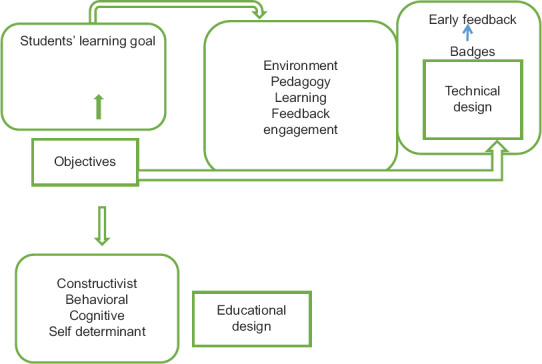
Study design
Figures 2-7 show the different parts of gamification and application.
Figure 2.
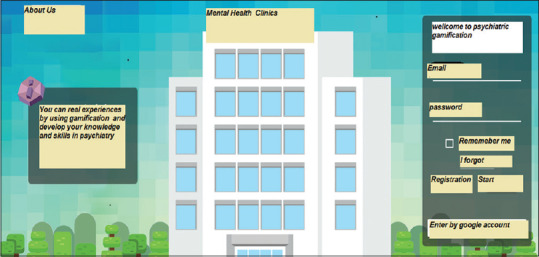
First page of gamification
Figure 7.
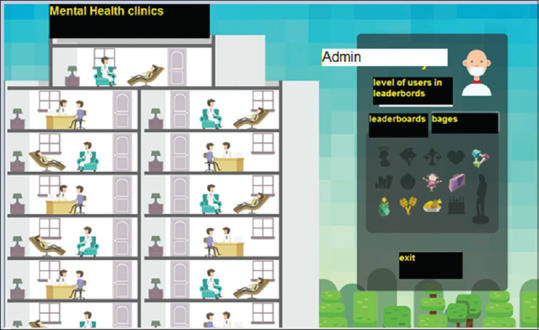
Main pages with leaderboard/badges/user level in leaderboard
Figure 3.
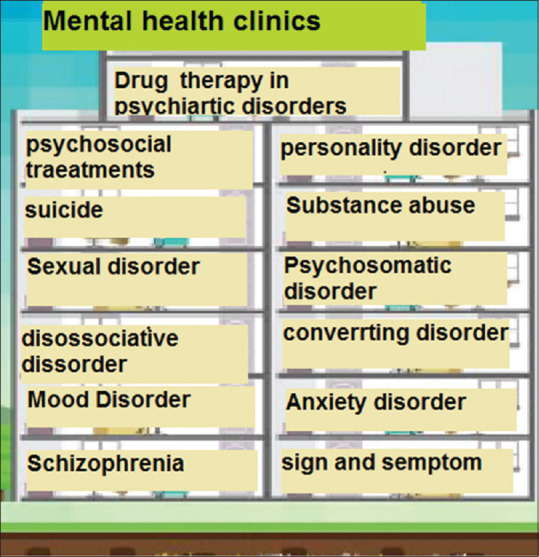
All parts of gamification in game process
Figure 4.
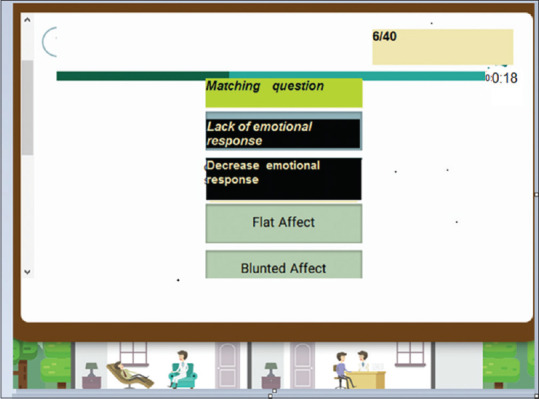
Matching questions in psychiatric gamification by time stress and number of question
Figure 5.
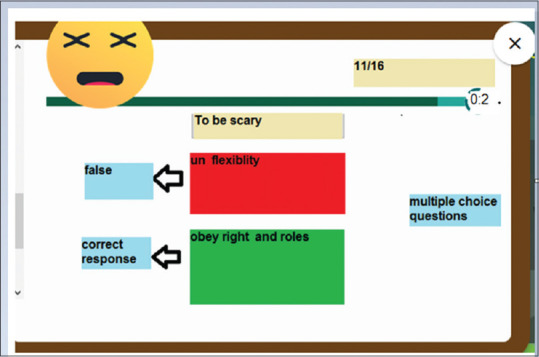
Multiple choice questions and feedback by time/question number and emoji
Figure 6.
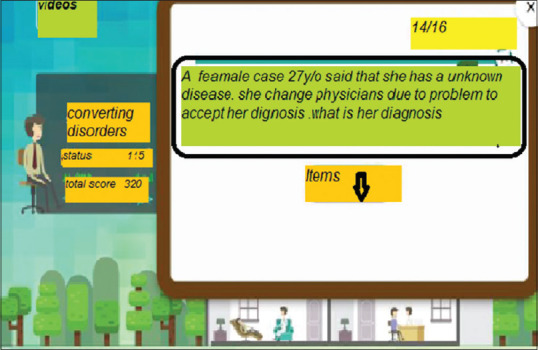
Case based question/status/total score of dimension
Design and development of gamification
In the design of the tool, a list of educational necessities was first considered in the course, followed by various sections. The first part was symptoms and symptoms of mental illness. This part is the important parts in students' knowledge that it was preferred to play and acquired necessary score and mastery to enter to another parts. Another part concluded 11 sections on psychiatric disorders (psychotic, mood disorders, anxiety, descriptive, analytical, transformational, psychosomatic, personality, and sexual), which were designed and considered for drug and psychosocial therapies. Scenario writing in each section is different and various sections on multiple-choice questions – drawing line – and working with simulated scenarios were considered to increase students' proficiency and enable them to gain deeper skills.
Gamification elements
In the scenario writing in the technical section, the three sections of dynamics, mechanisms, and elements of gamification are taken into consideration. Dynamics include things such as interdepartmental communication skills, upgrades, narrators of emotional situations, and limiters to keep the game dynamic. The mechanism section addresses challenges, opportunities, competitions, collaborations, feedback, access to resources, rewards, segmentation, frequent rotations and rewarding situations, and key elements of the game such as using avatars, models, sets, battles, increasing degrees of freedom, receiving gifts, leaderboards, dams, group comparison tables, team status, and virtual goods were used as elements.
Participants
Classes for mental health in specific part (mental illness) were set from the period of March 2017 to June 2017 and August 2018 to September 2018. Sampling was consensus by a quasi-experimental study in three groups (public health students, medical students, and laboratory sciences students with mental health, psychology, and health psychology, respectively).
Model and intervention
The flex model is a method of teaching for students who are nontraditional learners. Learning material and instructions are given online, and the lessons are self-guided. The teacher is available on-site. The students work independently and learn to develop and create new concepts in a digital environment.[27]
Educational strategies by student center learning by one model of blended learning (flex model) used in this study. This model is a flexible learning environment.[28]
To applied flex model from blended learning, the following phases are considered: Define learning object, concept presentation from lecture, blended course by gamification (using gamification online by students and teacher supervise students' learning in class, this model provides great opportunities for individualization of learning). This process is followed by small-group collaborative learning for discussion and teacher supervision followed by online (learning management system) and individual task. Finally, the activity of the students is evaluated.
Flex model in public science students and self-blended model in medical and laboratory sciences students was trained. These students used to gamification as a flex model in their learning. Evaluation was done about the students' satisfaction by open-ended questions in the final examination. And then, main rephrased themes were extracted. Furthermore, gamification effectiveness was assessed by a questionnaire. The data were collected through a questionnaire with 23 items in 5 continuums for the evaluation of students' motivation (n = 32). This questionnaire was validated by translation-retranslation and applied on 20 students. (The validity of the questionnaire was measured based on the content validity using the experts' views.) Furthermore, the reliability of the questionnaire was confirmed using a correlation coefficient of 0.74.[29,30]
All ethical issues were considered and proposal of extracted from the article confirmed by Jahrom Ethical Committee, with code number (IR.jums.REC.1396.002). “This project was funded by the National Agency for Strategic Research in Medical Education, Tehran, Iran, Grant No. 980991.”
Results
Participant' characteristics list in [Table 1].
Table 1.
Descriptive analysis in study
| Discipline | Number of gamification parts | Courses | Number of students |
|---|---|---|---|
| Public health | 7 | Mental health | 31 (2 continues year) |
| Medical | 4 | Health psychology | 43 |
| Laboratory sciences | 4 | Psychology | 23 |
The results from students' prospective about the efficacy of the method showed that the mean scores of most of the items were higher than the average. This implies that the students' attitude toward using gamification was positive.
The high mean score of perceived usefulness, perceived ease of use (PEOU), attitude, skill engagement, and interaction engagement list is shown in Table 2.
Table 2.
The effect of gamification on students’ engagement and motivation
| Mean | SD | SE | |
|---|---|---|---|
| PU items/measurement | |||
| Using the online gamification system improves my learning performance | 3.47 | 0.91 | 0.32 |
| Using the online gamification system increases my learning outcome | 3.72 | 0.83 | 0.14 |
| Using the online gamification system enhances my desire to produce desired result in my learning | 3.94 | 1.36 | 0.17 |
| Using the online gamification system is useful in my learning | 4.36 | 0.74 | 0.18 |
| PEOU items/measurement | |||
| I find the online gamification system to be flexible to be used | 3.79 | 0.34 | 0.16 |
| The online gamification functionality and interface is clear and understandable | 4.63 | 1.52 | 0.32 |
| Interacting with the online gamification system does not require a lot of my mental effort | 2.38 | 1.65 | 0.25 |
| Overall, I believe that the online gamification system is easy to use | 4.23 | 0.64 | 0.19 |
| A/measurement | |||
| I think that using online gamification system is a good idea | 4.13 | 1.23 | 0.22 |
| I like learning with online gamification system | 3.78 | 1.64 | 0.24 |
| I look forward to those aspects of my learning that require the use of online gamification system | 3.72 | 1.34 | 0.43 |
| SKE/measurement online gamification system encourage me in | |||
| Taking good notes in classroom | 3.09 | 1.28 | 0.32 |
| Listening carefully in classroom | 4.81 | 1.20 | 0.17 |
| Making sure to study on regular basis | 3.36 | 1.23 | 0.15 |
| IE/measurement gamification system contribute to me in | |||
| Having fun in the classroom | 4.13 | 0.62 | 0.04 |
| Participating actively in small-group discussions | 3.23 | 1.13 | 0.22 |
| Helping fellow students | 3.69 | 1.24 | 0.33 |
| Asking questions when I did not understand the lecturer | 3.92 | 0.55 | 0.34 |
PU=Perceived usefulness, PEOU=Perceived ease of use, A=Attitude, SKE=Skill engagement, IE=Interaction engagement, SD=Standard deviation, SE=Standard error
In the other part, the qualitative results of the study were analyzed and the students' analysis of their advantages and disadvantages and their perceptions of the impact of the intervention was examined. The extracted themes included the following items [Table 3].
Table 3.
Advantages and disadvantages of gamification through blended learning
| Creating a fun and motivating environment for learning |
| Creating healthy group and individual competition among students |
| Increasing and deepening the students’ learning and retention |
| Requiring careful study in answering the questions |
| Being different from traditional education |
| Fun and effective technology in the classroom |
| Good sense of power and mastery of learning contents |
| The difficult, yet being challenging and fun, nature of learning |
| Not getting tired of learning and learning from mistakes |
| Relationship between theoretical and practical content and link to the past comprehensive experiences |
| Learning from the misconceptions of knowledge in understanding |
| Weak points |
| The difficulty of the questions and the need to fully master the learning content |
| The need for a thorough and in-depth understanding of course content |
| Necessity of time management in solving questions |
| Not taking some members of the group seriously |
Discussion and Conclusion
The results of this study showed that students tended to use gamification if it was easy to access and use, as well as agreeing that it was useful in their learning. The results of the analysis of the findings of this study show that the efficiency and effectiveness of mental gamification is high. Based on the mean and standard deviation (SD) obtained in terms of student usefulness, they strongly agree with the usefulness of mental gamification, indicating that all students agreed that using classroom gamification technology could be effective in their learning.
Several elements have been used in gamification design that has been used in numerous studies, and the positive effects of each of the different dimensions have been discussed in the studies. In this study, motivational elements were used in gamification design and it was found that these components had a positive impact on motivation and positive attitude of users and had a positive effect on learning indicators. Much evidence supports this and emphasizes its impact.[31,32,33,34,35]
The impact of play on learning, performance, motivation, and satisfaction has also been emphasized in many studies. These data corroborate the qualitative and quantitative findings of the present study.[36,37,38,39,40] The impact of play on motivation as an important and influencing factor on learning has been confirmed in many studies.[41,42] Moreover, some also emphasize its impact on performance.[43,44]
Lee and Hammer study has shown that gamification can be effective in the students' learning and enhances the learners' problem-solving skills in a complex format that encourages the learners to explore the problem.[45] In a study by Wang and Lieberoth that examined the effect of attention and noise on focus, interaction, enjoyment, learning, motivation, and classroom dynamics using the Kahoot-based learning platform on 593 students, the results revealed that the use of the Kahoot-based learning platform had a positive effect on classroom dynamics, learning interaction, and students' motivation.[46]
Some evidence showed that gamification has positive effects and also confirmed the recent results and before evidence.[31,47]
Therefore, the results of this study are in line with the present study and show that gamification can be effective in teaching and learning.
Furthermore, the mean and SD of the “ease of use” score was 2–4, indicating that generally, the students agree with the ease of use of gamification technology in this study, which is in line with Rahman et al.'s study results. In this study, the results showed that students, in particular, tended to engage in activities that were easier to use the platform than the benefits they could derive from the product. It was concluded that intended ease of use (PEOU) was a better indicator of the students' attitude toward gamification.[30]
A study by Cheong et al. that examined the students' perceptions of game elements showed that all elements of the game presented to respondents were highly rated. Moreover, it was found that undergraduate students had a positive understanding of the systems that used game elements and were interested in using them for learning[48] which is consistent with the results of the present study.
In the area of interaction and participation and the use of skills, the results also indicated that mental gamification was effective in the students' interaction in the classroom, and research has shown that game elements may actually increase the levels of intrinsic motivation.[49] In a study by da Rocha Seixas et al. that examined the effectiveness of gamification on student engagement, it was found that gamification had a positive effect on student interaction,[50] which is consistent with the results of this study and both confirm the effectiveness of gymnastics on the amount of learner interaction in the classroom. Another evidence showed that game elements must be used correctly and appropriately, strategically, and appropriately in order to create a high level of active participation and motivation, which also motivates learning. In turn, it can produce positive results in cognitive, emotional, and social domains.[51]
Studies from behavioral and psychological outcomes showed that gamification can be effective to this dimension positively.[52,53,54]
Atmacasoy and Aksu in their review study of Turkish universities found that blended learning had a positive effect on the students' motivation and success, which is consistent with the present study.[55] Also the effect of blended learning on learning, critical thinking and attribution style.[56,57]
Although some evidence showed that using game mechanics had a positive impact on students' motivation to engage in more challenging activities during the course. In the present study, mental gamification also influenced the students' interaction in the classroom.[58]
Studies have shown that blended learning, in the form of gamification, has better learning than other students who receive simple instruction,[59,60] which is consistent with the results of the present study in students' interview.
Thus, the results of this study suggest that the structure of students' interaction can be a measure of their acceptance of the use of gamification. However, PEOU, usefulness, and perceived attitudes toward using gamification technology structures should generally be taken into account in the student participation orientation to be able to attract the learners to enhance the student engagement and interaction in the classroom. One of the limitations of this study was the shortage of samples of two groups of students in two consecutive years. However, taking advantage of it at the level of group in the learning environment provided the opportunity to interact and explore dynamic classroom processes.
Development of gamification intervention by blended models is an innovating educational program in Iran and educational context. This gamification not only needs to develop by different groups but also needs to assess the effect of gamification on students' learning and learning indicators. Furthermore, we suggest more research to compare students' learning in new and traditional educational approach. The findings of this study provide educational pattern for further educational studies as well as for the researchers in our country.
Conclusion
The results indicated the positive effects of this intervention on learning and their satisfaction indices. It is necessary to examine the use of this method in different groups and units in order to use and develop the positive effects of technology on education. Using the theory of constructivism, this approach can make an important contribution to the construction of knowledge and active, student-centered learning.
Financial support and sponsorship
This study was financially supported by Jahrom University of Medical Sciences, Jahrom, Iran.
Conflicts of interest
There are no conflicts of interest.
Acknowledgment
I appreciate all students participating in this study and also Jahrom University of Medical Sciences for financial support. We greatly appreciate the National Center for Strategic Research in Medical Education (NASR). “This project was funded by the National Agency for Strategic Research in Medical Education, Tehran, Iran, Grant No. 980991.”
References
- 1.Novak J, Levy L. Play the game: the parent's guide to video gamesTHOMSON Cengage Learning. 2008 [Google Scholar]
- 2.Mochocki M. Reality is Broken: Why Games Make Us Better and How They Can Change the World Jane McGonigal 2011. New York: Penguin Press, ss 388 Czasopismo ludologiczne Polskiego Towarzystwa Badania Gier; 2011. p. 239. [Google Scholar]
- 3.Prensky M. Digital game-based learning. Computers in Entertainment (CIE) 2003 Oct 1;1(1):21–21. [Google Scholar]
- 4.Urh M, Vukovic G, Jereb E. The model for introduction of gamification into e-learning in higher education. Proc Soc Behav Sci. 2015;197:388–97. [Google Scholar]
- 5.Perrotta C, Featherstone G, Aston H, Houghton E. Game-Based Learning: Latest Evidence and Future Directions NFER Research Programme: Innovation in Education Slough. NFER. 2013:1–49. [Google Scholar]
- 6.Corti K. Games-based Learning; a serious business application. Inf Pixel Learn. 2006;34:1–20. [Google Scholar]
- 7.Federation of American Scientists. Summit on educational games: Harnessing the power of video games for learning. Washington, DC: 2006. [Google Scholar]
- 8.Kapp KM. The gamification of learning and instruction fieldbook: Ideas into practice. John Wiley and Sons; 2013. [Google Scholar]
- 9.Landers RN. Developing a theory of gamified learning: Linking serious games and gamification of learning. Simul Gaming. 2014;45:752–68. [Google Scholar]
- 10.Landers RN, Landers AK. An empirical test of the theory of gamified learning: The effect of leaderboards on time-on-task and academic performance. Simul Gaming. 2014;45:769–85. [Google Scholar]
- 11.Deterding S. Gamification: designing for motivation. interactions. 2012;19:14–7. [Google Scholar]
- 12.Burke B. Gamify: How gamification motivates people to do extraordinary things. Routledge; 2016. [Google Scholar]
- 13.Putz LM, Treiblmaier H. Creating a theory: Based research agenda for gamification. Twentieth Americas Conference on Information Systems, Savannah. 2015 [Google Scholar]
- 14.Robson K, Plangger K, Kietzmann JH, McCarthy I, Pitt L. Is it all a game? Understanding the principles of gamification. Bus Horiz. 2015;58:411–20. [Google Scholar]
- 15.Ruhi U. Level up your strategy: Towards a descriptive framework for meaningful enterprise gamification. Technol Innov Manage Rev. 2015;5:5–16. [Google Scholar]
- 16.Betts BW, Bal J, Betts AW. Gamification as a tool for increasing the depth of student understanding using a collaborative e: Learning environment. Int J Contin Eng Educ Life Long Learn. 2013;23:213–28. [Google Scholar]
- 17.Nah FF, Telaprolu VR, Rallapalli S, Venkata PR, editors . Gamification of Education Using Computer Games International Conference on Human Interface and the Management of Information. Springer; 2013. [Google Scholar]
- 18.Moskal P, Dziuban C, Hartman J. Blended learning: A dangerous idea? Internet High Educ. 2013;18:15–23. [Google Scholar]
- 19.Saritepeci M, Cakir H. The effect of blended learning environments on student motivation and student engagement: A study on social studies course. Egitim ve Bilim. 2015;40(177):203–216. [Google Scholar]
- 20.Tolley B. Creating Successful Blended Learning Classrooms. 2014. Available from https://wwwedweekorg/tm/articles/2014/10/08/ctq_tolley_blended_learninghtml .
- 21.Powell A, Watson J, Staley P, Patrick S, Horn M, Fetzer L, et al. Blending Learning: The Evolution of Online and Face-to-Face Education from 2008-2015. Promising Practices in Blended and Online Learning Series International Association for K-12 Online Learning. 2015 [Google Scholar]
- 22.Farrell GF. Using a blended learning model to facilitate personalization of reading instruction for primary students Dissertation for educational leadership. Vancouver university; 2018. Dec, [Google Scholar]
- 23.Holley D, Oliver M. Student engagement and blended learning: Portraits of risk. Comput Educ. 2010;54:693–700. [Google Scholar]
- 24.Rossett A, Frazee RV. Blended Learning Opportunities. New York: American Management Association; 2006. [Google Scholar]
- 25.National Research Council. A Framework for K-12 Science Education: Practices, Crosscutting Concepts, and Core Ideas. Washington, DC: The National Academies Press; 2012. https://doiorg/1017226/13165 . [Google Scholar]
- 26.Dicheva D, Dichev C, Agre G, Angelova G. Gamification in education: A systematic mapping study. Educ Technol Soc. 2015;18:75–88. [Google Scholar]
- 27.Bailey J, Martin N, Schneider C, Vander Ark T, Duty L, Ellis S, et al. Blended Learning Implementation Guide 20 Digital Shift. 2013 [Google Scholar]
- 28.Graham CR, Henrie CR, Gibbons AS. Developing models and theory for blended learning research. Blended learning: Research perspectives. 2014;2:13–33. [Google Scholar]
- 29.Mosalanejad L, Abdollahifard S. Gamification in Psychiatry: Design and development of native model and the innovate strategy in medical education as a funny and exciting learning. PJMHS. 2018;12(4):1820–28. [Google Scholar]
- 30.Rahman RA, Ahmad S, Hashim UR. The effectiveness of gamification technique for higher education students engagement in polytechnic Muadzam Shah Pahang, Malaysia. Int J Educ Technol High Educ. 2018;15:41. [Google Scholar]
- 31.Denny P, editor. The Effect of Virtual Achievements on Student Engagement Proceedings of the SIGCHI Conference on Human Factors in Computing Systems Association for Computing Machinery. 2013 [Google Scholar]
- 32.Domínguez A, Saenz-De-Navarrete J, De-Marcos L, FernáNdez-Sanz L, Pagé SC, MartíNez-HerráIz JJ. Gamifying learning experiences: Practical implications and outcomes. Comput Educ. 2013;63:380–92. [Google Scholar]
- 33.Guin TD, Baker R, Mechling J, Ruyle E. Myths and realities of respondent engagement in online surveys. Int J Market Res. 2012;54:613–33. [Google Scholar]
- 34.Gustafsson A, Katzeff C, Bang M. Evaluation of a pervasive game for domestic energy engagement among teenagers. Comput Entertain. 2009;7:54. [Google Scholar]
- 35.Hamari J. Transforming homo economicus into homo ludens: A field experiment on gamification in a utilitarian peer-to-peer trading service. Electron Commer Res Appl. 2013;12:236–45. [Google Scholar]
- 36.Berns A, Isla-Montes JL, Palomo-Duarte M, Dodero JM. Motivation, students' needs and learning outcomes: A hybrid game-based app for enhanced language learning. Springerplus. 2016;5:1305. doi: 10.1186/s40064-016-2971-1. [DOI] [PMC free article] [PubMed] [Google Scholar]
- 37.Ibanez MB, Di-Serio A, Delgado-Kloos C. Gamification for engaging computer science students in learning activities: A case study. IEEE Trans Learn Technol. 2014;7:291–301. [Google Scholar]
- 38.Knautz K, Wintermeyer A, Orszullok L, Soubusta S, editors. From know that to Know How – Providing new Learning Strategies for Information Literacy Instruction European Conference on Information Literacy. Springer; 2014. [Google Scholar]
- 39.Mosalanejad L, Razeghi B, Ifard SA. Educational Game: A fun and team based learning in psychiatric course and its effects on learning indicators. Bangladesh J Med Sci. 2018;17:631–7. [Google Scholar]
- 40.Panagiotis F, Theodoros M, Leinfellner R, Yasmine R. Climbing up the leaderboard: An empirical study of applying gamification techniques to a computer programming class. Electron J E Learn. 2016;14:94–110. [Google Scholar]
- 41.Harms J, Seitz D, Wimmer C, Kappel K, Grechenig T. Low-cost Gamification of Online Surveys: Improving the user Experience through Achievement Badges Proceedings of the 2015 Annual Symposium on Computer-Human Interaction in Play. Association for Computing Machinery; 2015. [Google Scholar]
- 42.Morschheuser B, Henzi C, Alt R, editors. Increasing Intranet Usage through Gamification--Insights from an Experiment in the Banking Industry 2015 48th Hawaii International Conference on System Sciences. IEEE; 2015. [Google Scholar]
- 43.Juźwin M, Adamska P, Rafalak M, Balcerzak B, Kąkol M, Wierzbicki A, editors. Association for Computing Machinery; 2014. Threats of Using Gamification for Motivating Web Page Quality Evaluation Proceedings of the 2014 Mulitmedia, Interaction, Design and Innovation International Conference on Multimedia, Interaction, Design and Innovation. [Google Scholar]
- 44.Krause M, Mogalle M, Pohl H, Williams JJ, editors. A Playful Game Changer: Fostering Student Retention in Online Education with Social Gamification Proceedings of the Second (2015) ACM Conference on Learning@. Scale Association for Computing Machinery; 2015. [Google Scholar]
- 45.Kiesler S, Kraut RE, Koedinger KR, Aleven V, Mclaren BM. Gamification in education: What, how, why bother? Academic exchange quarterly. 2011;15:1–5. [Google Scholar]
- 46.Wang AI, Lieberoth A, editors. The Effect of Points and Audio on Concentration, Engagement, Enjoyment, Learning, Motivation, and Classroom Dynamics using Kahoot. European Conference on Games Based Learning Academic Conferences International Limited; 2016. [Google Scholar]
- 47.Hamari J, Koivisto J. Social Motivations to use Gamification: An Empirical Study of Gamifying Exercise In Proceedings of the European Conference on Information Systems Utrecht. The Netherlands; 2013. [Google Scholar]
- 48.Cheong C, Filippou J, Cheong F. Towards the gamification of learning: Investigating student perceptions of game elements. J Inf Syst Educ. 2014;25:233–244. [Google Scholar]
- 49.Sailer M, Hense JU, Mayr SK, Mandl H. An experimental study of the effects of specific game design elements on psychological need satisfaction. Comput Hum Behav. 2017;69:371–80. [Google Scholar]
- 50.da Rocha Seixas, Gomes AS, de Melo Filho IJ. Effectiveness of gamification in the engagement of students. Comput Hum Behav. 2016;58:48–63. [Google Scholar]
- 51.Faiella F, Ricciardi M. Gamification and learning: A review of issues and research. J E Learn Knowl Soc. 2015;11 Retrieved December 16, 2019. from https://wwwlearntechliborg/p/151920/ [Google Scholar]
- 52.Mosalanejad L, Abdollahifard S. Gamification in psychiatry: Design and development of native model and the innovate strategy in medical education as a funny and exciting learning. PJMHS. 2018;12:1820–28. [Google Scholar]
- 53.Anderson A, Huttenlocher D, Kleinberg J, Leskovec J. Proceedings of the 22nd International Conference on World Wide Web. Association for Computing Machinery; 2013. Steering User Behavior with Badges; pp. 95–106. [Google Scholar]
- 54.Eickhoff C, Harris CG, de Vries AP, Srinivasan P. Proceedings of the 35th International ACM SIGIR Conference on Research and Development in Information Retrieval. Association for Computing Machinery; 2012. Quality Through flow and Immersion: Gamifying crowdsourced Relevance Assessments; pp. 871–80. [Google Scholar]
- 55.Atmacasoy A, Aksu M. Blended learning at pre-service teacher education in Turkey: A systematic review. Educ Inf Technol. 2018;23:2399–422. [Google Scholar]
- 56.Mosalanejad L, Alipor A, Zandi B, Zare H, Shobeiri SM. The blended educational program as a modified educational program in medical education and the effect on students' critical thinking. Middle East J Nurs. 2014;101:1–6. [Google Scholar]
- 57.Mosalanejad L, Alipor A. A blended education program based on critical thinking and its effect on personality type and attribution style of the students. Turkish Online J Distance Educ. 2010;11:185–96. [Google Scholar]
- 58.Tan M, Hew KF. Incorporating meaningful gamification in a blended learning research methods class: Examining student learning, engagement, and affective outcomes. Australas J Educ Technol. 2016;32(5) https://doiorg/1014742/ajet 2232 . [Google Scholar]
- 59.Lam YW, Hew K, Chiu KF. Improving argumentative writing: Effects of a blended learning approach and gamification. Lang Learn Technol. 2018;22:97–118. [Google Scholar]
- 60.Fan KK, Xiao PW, Su CH. The effects of learning styles and meaningful learning on the learning achievement of gamification health education curriculum. Eur J Math Sci Technol Educ. 2015;11:1211–1229. [Google Scholar]


